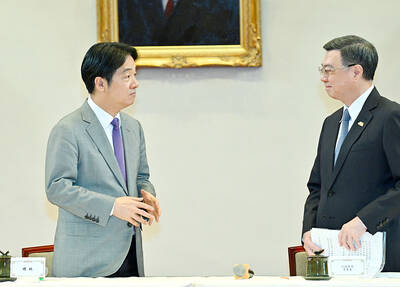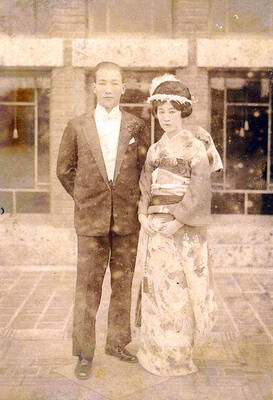USB memory sticks
Those pen cap-sized memory storage devices known as USB hard drives have become so prevalent many companies are giving them away. Months ago, this newspaper received a press kit in the mail for the Dakar Rally which contained the usual swag of materials; event info, t-shirt, etc. But instead of providing prints of photos for the event, the organizers got creative and put all their photos on a USB stick emblazoned with their logo and strung from a lanyard.
Here in Taiwan, there are so many manufacturers of these inexpensive gadgets it seems every other household has an assembly line in their living room -- which may not be far from the truth. Manufacturing costs are low. It often costs little more to make a USB stick than to assemble a ball-point and some pens actually include a USB storage device under a cap on the non-writing end. Other USB sticks double as digital voice recorders, FM radios, MP3 players, Web cams, Wi-Fi antennae, or any combination of the above. Rarely do their prices rise above US$100.
The ancestor of these devices is of course the floppy disk. I recall having to buy my first 3.5 disk for my high school computer class. Everything I did in that semester-long class fitted onto the 1.44MB disk. Not long after that, disks were sold in packs of 10 and 20 before eventually taking on a new role as drinks coasters.
Portable storage then took the form of Zip and Jazz drives, but these were primarily the property of geeks and designers with huge graphics files. The writable CD became, and remains, the preferred storage for anyone wanting to back up their data ahead of the blue screen of death, but the USB stick has rapidly become the favorite form of removable media.
And why not? The devices have increased in capacity almost as quickly as they've come down in price. Two years ago, a 32MB stick cost about NT$1,200. Now that same amount can buy you 256MB of memory. But why buy a simple, boring memory stick when, for not much more money, you can buy one that will, say, let you listen to the radio or play MP3 files during your workout, or allow you to record verbal reminders throughout the day while it hangs from your key ring? What about one that will record your favorite radio program for you to listen to later in the day?
There are three basic categories of USB stick; those that serve only as memory storage devices, three-in-one devices and, five-in-one devices. The first of these, being the simplest, is the least expensive and the least fun. However, as USB memory storage involves no moving parts, they're also the most solid-state of the devices. This means attaching it to your key chain and throwing it onto the table when you get home is not a problem.
The same cannot be said of USB sticks that double as MP3 players, radios of voice recorders. While there are still not many moving parts in these gadgets, the parts that do move are the buttons and switches that allow you to operate its various functions -- break them and you have a simple USB storage device.
Therefore, one of the most important things to look for in a device -- besides what functions you want it to include -- is how solidly constructed it is. Of the sticks tested for this review, Acer's model (NT$3,000) and the MSI Megastick (NT$2,950) seemed the least likely to shatter if dropped onto the pavement. Both are five-in-one models, meaning they store 128MB of data, play MP3s, have an FM radio receiver and can record radio or take dictation.
The Megastick includes a necklace lanyard that conceals a pair of ear bud-style speakers. Unfortunately, the speakers that it ships with are rather poor and don't match up to the Megastick's high noise-to-sound decibel rating. If you want to get the full sound the device is capable to putting out, you have to upgrade headphones, but then you still have the ones the device ships with stick inside the lanyard -- a good design idea poorly executed. Also, the cap covering the USB mount and the battery cover both tend to come off too easily -- a problem with many of these devices. These problems of construction quality were most prevalent in the Ennyah (
Other problems are more inherent to the devices than a result of poor design. If you're wanting to take several hours of music with you, a 128MB stick is only going to hold roughly two albums of music with a bit of space left over for holding a bit of other data. The 256MB models hold more, but if your primary desire is having a small MP3 player, it would be best to look at other types of devices or hold off for a while. The next generation of these devices promise memory space of 500MB and even 1GB. Of course, then they'll likely be as expensive as more common types of MP3 players.
One last word of warning regards the devices' data storage capabilities. Many of these devices ship with a CD that includes software which will allow your machine to recognize the device. Others, more smartly, are designed to be recognized by any machine in which you plug them into without software. If you're wanting to download a new album of music to share with a friend, their computer may not recognize your USB stick when you attach it to their computer. Mac users will also want to be sure to buy the no-software-necessary models.

Under pressure, President William Lai (賴清德) has enacted his first cabinet reshuffle. Whether it will be enough to staunch the bleeding remains to be seen. Cabinet members in the Executive Yuan almost always end up as sacrificial lambs, especially those appointed early in a president’s term. When presidents are under pressure, the cabinet is reshuffled. This is not unique to any party or president; this is the custom. This is the case in many democracies, especially parliamentary ones. In Taiwan, constitutionally the president presides over the heads of the five branches of government, each of which is confusingly translated as “president”

Sept. 1 to Sept. 7 In 1899, Kozaburo Hirai became the first documented Japanese to wed a Taiwanese under colonial rule. The soldier was partly motivated by the government’s policy of assimilating the Taiwanese population through intermarriage. While his friends and family disapproved and even mocked him, the marriage endured. By 1930, when his story appeared in Tales of Virtuous Deeds in Taiwan, Hirai had settled in his wife’s rural Changhua hometown, farming the land and integrating into local society. Similarly, Aiko Fujii, who married into the prominent Wufeng Lin Family (霧峰林家) in 1927, quickly learned Hoklo (commonly known as Taiwanese) and

The Venice Film Festival kicked off with the world premiere of Paolo Sorrentino’s La Grazia Wednesday night on the Lido. The opening ceremony of the festival also saw Francis Ford Coppola presenting filmmaker Werner Herzog with a lifetime achievement prize. The 82nd edition of the glamorous international film festival is playing host to many Hollywood stars, including George Clooney, Julia Roberts and Dwayne Johnson, and famed auteurs, from Guillermo del Toro to Kathryn Bigelow, who all have films debuting over the next 10 days. The conflict in Gaza has also already been an everpresent topic both outside the festival’s walls, where

The low voter turnout for the referendum on Aug. 23 shows that many Taiwanese are apathetic about nuclear energy, but there are long-term energy stakes involved that the public needs to grasp Taiwan faces an energy trilemma: soaring AI-driven demand, pressure to cut carbon and reliance on fragile fuel imports. But the nuclear referendum on Aug. 23 showed how little this registered with voters, many of whom neither see the long game nor grasp the stakes. Volunteer referendum worker Vivian Chen (陳薇安) put it bluntly: “I’ve seen many people asking what they’re voting for when they arrive to vote. They cast their vote without even doing any research.” Imagine Taiwanese voters invited to a poker table. The bet looked simple — yes or no — yet most never showed. More than two-thirds of those